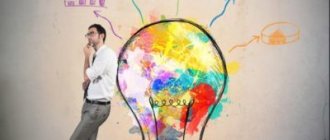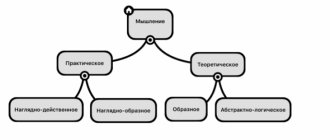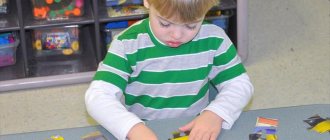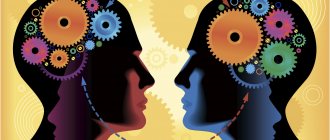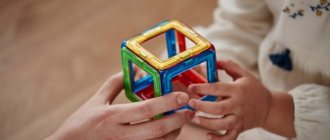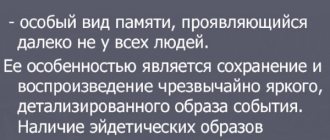Thinking helps us to understand the essence of things, thanks to it we compare and classify, analyze and specify, generalize and highlight the most essential.
According to the content, they divide visual-effective, visual-figurative and verbal-logical (abstract) thinking. We observe the development of visual and effective thinking when a small child begins to explore the world, becoming familiar with the objects around him and manipulating them. By the time a child enters school, as a rule, this type of thinking is fully formed. The most intensive development of visual and effective thinking occurs at the age of three to four years.
The development of visual-figurative thinking occurs at the age of about six to seven years, when children begin to imagine the objects or phenomena around them. Verbal-logical thinking develops even later, as the next stage in the development of thinking, while children learn to reason using concepts.
Visual-figurative and visual-effective are practical types of thinking; they also belong to the group of pre-conceptual thinking. This is due to the fact that they are based on a specific, direct reflection of reality, and the use of concepts is still unconscious, random.
The development of visual thinking in children will subsequently become the foundation for the formation of verbal-logical (conceptual) thinking, which plays a leading role in human life. Adults are capable of all types of thinking, but they can be developed to varying degrees.
Development of visual thinking in children
Visual and effective thinking is formed in the process of getting to know the world around us, during the game, and its development presupposes the effective participation of an adult, his help in organizing games, his control and support. Children, under the guidance of an adult, learn more about the properties of objects, learn to use them, establish connections and relationships, and solve various problems in practice using objects. By the age of six or seven, a child can already perform various tasks based on a visual example, compare the shape of objects or parts and their sizes.
One of the most effective activities that contribute to the development of visual forms of thinking is construction. Therefore, it is so important that the child plays with construction toys made of different materials, different shapes and different types. Exercises with scissors and paper and folding figures from matches serve the same purpose.
With the help of auxiliary materials (construction sets, matches, counting sticks), children build houses and garages, tables and benches, ladders, bridges and much more. The child builds according to the model, and if he doesn’t succeed, the adult shows him how to act, and the child imitates. If this is difficult, the adult does it himself, and the child helps him, and then tries it himself. For example, you can lay out flat figures on the table using a certain number of matches, or move one or more matches so that a different figure is obtained.
Thanks to interaction with an adult, the child not only develops visual forms of thinking, but also receives new impressions and develops speech. The difficulty of tasks should gradually increase.
As we have already said, visual-figurative thinking is based on visual-effective thinking. It arises gradually, as the child gains enough practical experience of action or thinks about how the situation can be changed, while imagining in his mind what needs to be done and what will happen as a result. Visual and effective thinking is necessary for a child’s successful education in elementary school. The child learns to solve problems in his mind, relying on questions (that is, on his idea of objects).
It is very important to increase the level of development of a child’s visual-figurative thinking, because it has a dominant role in the process of his cognition of the world around him. Thanks to visual-figurative thinking, the child acquires knowledge and gets an idea of what is happening. In addition, it gives rise to the first shoots of children's creativity. The level of development of visual and figurative thinking achieved in the preschool years is important for the rest of a person’s life: it is an invaluable contribution to the overall process of human mental development.
The development of visual-figurative thinking is facilitated by passing labyrinths, drawing and designing. But design is not based on a given model, but on the basis of an adult’s verbal instructions or by implementing an idea conceived by the child himself. Thanks to the development of visual thinking, the child uses diagrams and makes calculations in his head. By the age of seven, children begin to develop verbal and logical thinking, allowing them to reason using abstract concepts.
Development of visual and effective thinking
The process of visual-effective thinking is distinguished by the practical transformation of real objects. The result of visually effective thinking is, first of all, action. For example, through several tests we determine which scissors are best to cut this fabric or this sheet of metal. Sometimes, as a result of visual and effective thinking, a new object appears: from available means we can create something needed. When dealing with new household appliances, performing repair work, performing mechanical, practical tasks, we use visual-effective thinking. Visual-effective thinking is widely used by people in working professions engaged in practical activities, that is, producing something concrete, material.
Visual-effective thinking allows us to cope with a particular task through trial and error. Insufficient development of visual-effective thinking in a child can subsequently lead to difficulties in learning, since classes will require the ability to foresee the result and plan one’s actions. The successful development of visual and effective thinking is facilitated by modeling and design, various didactic exercises and games, practical acquaintance with objects - tools and objects with which they can be replaced.
Development of visual-figurative thinking
The result of visual-figurative thinking is an image: we can imagine how we will look in these clothes, or imagine what our bedroom will look like after pasting this wallpaper, or how this chandelier (this bedspread, etc.) will fit into the interior. When creating a plan to achieve a result in our imagination, we use visual-figurative thinking. Visual-figurative thinking is best seen in the thinking of children - preschoolers and primary schoolchildren. It is also actively used by adults, especially managers and people in professions in which it is necessary to make decisions regarding the subject of activity without directly interacting with it, but only by observing it.
To develop visual-figurative thinking, it is important to help a child (as well as an adult) to liberate their imagination, fantasize more boldly, and develop the desire to create new images.
Conventionally, exercises and tasks that promote the development of visual-figurative thinking can be divided into teaching two things:
- Combine
- Transform.
Exercises of the first type consist of putting together something completely new from given images (symbols) - and these can be various kinds of figures, numbers, signs, pictures, and so on. For example, suggest using numbers, mathematical signs, letters to make a human figure (circle - face, dots or brackets - closed eyes and mouth, comma - nose, triangle - dress, equal sign - legs, "greater than" and "less than" signs - bent in the elbows of the arm.As an option, ask them to show their imagination and give them the freedom to fold any figure.
Exercises of the second type consist in making changes to it, based on the provided solid image, in order to get something new. This includes, for example, problems with matches (sticks), in which it is necessary to transform one figure into another through certain actions. You can give the task to think about how you could change and improve the image of the person depicted in the photograph. You can ask to complete the proposed element (for example, a printed letter) to any recognizable image. For example, it is easy to “hang” a bowl on both sides of the letter “T”, turning it into a scale.
In the development of thinking, as well as other mental processes, a huge role belongs to games, during which the child gets acquainted with the properties of objects, their features, and studies them, using different senses, in a comprehensive manner.
Study of visual-effective and visual-figurative forms of thinking
Thinking is a very complex holistic and at the same time concrete form of mental activity. The thinking process of children is aimed at obtaining new information about an object and involves the use of not only familiar methods of action.
At preschool age, the transition from visual-effective to visual-figurative thinking occurs.
In middle preschool age (4-5 years), the most characteristic form of thinking for a child is visual-figurative thinking. At this age, a child can solve problems not only in the process of practical actions with objects, but also in his mind, relying on his figurative ideas about objects.
4 years is a turning point in the development of imaginative thinking.
The thinking of young children is figurative in nature. The study of the development of children's thinking in ontogenesis shows that three main forms of thinking consistently arise, develop and closely interact with each other in a child: visual-effective - “manual”, then, as visual and mental operations develop and perform actions with an object, - “ in the mind” and relying on images (representations) of these objects - thinking acquires the features of visual-figurative, which in turn, in the near future, will become the basis for verbal-logical and moving the range of concepts beyond the framework of children's direct experience.
By the end of preschool age, by 6-7 years, the child develops logical thinking. The ability to reason logically is closely related to the child’s accumulation of experience and the development of his ideas about the surrounding reality.
Speech plays a major role in the development of logical forms of thinking, which becomes a tool of thinking, a means of planning and controlling activity, although the previous two forms of thinking are also carried out with the participation of speech.
Speaking about the relationship between different types of thinking in children, one should remember their specificity, which is clearly manifested in the ontogenesis of thinking and is characterized by the peculiarities of the means, methods of implementation and functions of each form of thinking. To study the individual and age-related characteristics of the thinking of children of primary preschool age, it is advisable to focus on the study of such forms as visual-effective and visual-figurative, as well as the level of speech development (impressive and expressive speech), for children 6-7 years old - written speech with identification of essential features of letters.
In addition to the author's methods, methodological materials published in the works of S. D. Zabramnaya, L. S. Tsvetkova, O. N. Usanova were used.
Execution procedure. Working hours are not standardized, the examination is carried out in a relaxed manner, in each specific case they establish their own style of communication (in some - affectionate and approving, in others business-like and strict).
Analysis of work results contains a qualitative description of the completion of the task.
The proposed tasks allow us to identify the development of such qualities of mental activity as arbitrariness, indirectness, perception of size, shape, color, spatial relationships, the ability to create a whole from parts, knowledge of generic categories, the ability to generalize based on the establishment of similar features, understanding of cause-and-effect relationships, etc. .
Task 1. Disassembling and folding matryoshka dolls of two, four, six parts (offered to children from 2 years old).
Target. A study of a child’s understanding of nonverbal instructions, adequacy, methods of action, use of assistance, comparison operation and ways of implementing it in activities. They monitor the state of motor skills, coordination, and dexterity. Presence and persistence of interest.
Equipment. Two-, four- and six-piece nesting dolls.
And the instruction can be gestural or verbal.
Execution procedure. The child is shown a nesting doll, which the researcher opens and folds. Then he offers a gesture to do the same. Children 3.5-4 years old are given verbal instructions: “Take apart and assemble the nesting doll. Arrange them by height. Give me the biggest matryoshka doll, the smallest one.”
2-3 year old children act by trial (this is acceptable). Children after 3.5-4 years - by | trying on and visual comparison.
Children use the help offered in the form of gestures and actively respond to facial expressions of approval and disapproval.
Task 2. Disassembling and folding the pyramid (from 2 years old).
Target. See task 1. Determining the maturity of the concept of size and color.
Equipment. Pyramids of 4, 6, 8 rings.
Instructions can be gestural or verbal.
Execution procedure. A pyramid is placed in front of the child and with a gesture they suggest taking it apart and then putting it back together. Additional instructions: “Give (show) the blue ring. Give me yellow... Give me two, give (show) the first, second ring...”
Children 2-3 years old can fold a pyramid without taking into account the size. For them, folding the pyramid and trying to fit the ring onto a closed cap will be inadequate. After 4 years, children use the method of visual correlation of rings. In cases where the child makes a mistake, repeated instructions are sufficient.
Instead of nesting dolls, they use blocks and cubes of different sizes, multi-colored sticks, and create figures according to the model (with support and from memory). They observe the nature and direction of the child’s activities, and the presence of self-control.
Task 3. Building a “fence” (offered from 3.5 years old).
Purpose of the study. Revealing an understanding of the purpose of the task and the ability to perform voluntary activities. Assessment of the level of self-control and motor skills.
Equipment. Strips of thick (“velvet”) paper in red (8 stripes) and white (8 stripes) colors measuring 10x3 cm. Use counting sticks or blocks.
Execution procedure. In front of the child, stripes are laid out in a row in a certain sequence: KBKBKB... Pay attention to their alternation by color and suggest with a gesture or words (“Continue yourself”) to lay out the remaining strips. If a child makes a mistake, they provide organizational assistance (facial expressions of displeasure, negative shaking of the head, comments such as “Be more careful,” “Look at the stripe”).
Children by the age of 3.5-4 years complete this task. Many of them have not always developed voluntary activity and self-control skills, but at the same time there are no inappropriate actions with strips and bars. In cases where children make mistakes, assistance in the form of organizing their activities is effective. The motor skills of some children are not sufficiently developed (the movements are awkward, and it is not possible to maintain an even row).
Task 4. “Mailbox” or box of forms (offered from 2.5 to 4 years) (Fig. 3.5).
Target. Study of the possibility of carrying out comparison operations and establishing the identity of objects. The child must grasp the principle of correlating the base of a three-dimensional figure with the shape of the slot; study of dexterity and accuracy of hand movements, determination of the dominant hand.
Equipment. A box containing 10 three-dimensional figures. Box dimensions: height 16 cm, width 12 cm and on the top cover there are 5 slots of the appropriate shape for 10 volumetric figures.
Instructions can be gestural or verbal.
Execution procedure. A box with figures is placed in front of the child; the figures are taken out. The researcher takes one of the figures, shows its base, draws a corresponding slot and lowers the figure into it. He gestures to continue working. Oral instructions may also be given: “Put all the figures in the box.” It is better to start the show with the simplest shapes (a cylinder with a circle at the base, a prism
with a triangle at the base). It is necessary to monitor the ability to reverse the figure.
Up to 3.5 years old, children can act with force (without taking into account the shape of the slots). From 3.5 to 4 years - by trying on, from 4 to 5 years - by visual correlation.
Task 5. Seguin boards (from 2 years old - boards with 4-6 liners, from 3 years - boards with 10-15 liners).
Target. Study of the level of formation of actions, identification and modeling, operations of analysis and synthesis in conditions of varying degrees and difficulties.
Equipment. Boards with grooves in which figures are inserted that exactly match the grooves (their configuration). There are 3 types of boards and with different numbers of tabs. On board #1, the inlays are entire, high-contrast elements. On board No. 2, the liners are solid, but their color matches the background of the board; on board No. 3 the liners are divided into separate parts.
The instructions can be in action or verbal (“Look, I have a board with figures. I’ll pour them out, and you put them back”).
Execution procedure. The child is shown a board with inserts, then in front of his eyes the board is overturned so that the inserts fall on the table. The child is asked to fill in the slots.
The execution rate is similar to that described in the “Mailbox” method.
Task 6. Multi-colored mosaic (offered from 3 years).
Purpose of the study. Identifying the ability to visually perceive colors, correlate similar ones, differentiate, know the names of colors. Ability to work according to oral instructions, following a model. Visual memory and motor skills are studied.
Equipment. A mosaic consisting of colored squares and circles, a total of 12 figures of each type: 2 green, 2 blue, 2 red, 2 black, 2 white, 2 yellow.
Execution procedure. The task includes 5 stages. At the 1st stage, the child is shown a multi-colored mosaic rug:
Then they silently take the blue square and place it on the corresponding “piece”. The gesture shows that the child should continue working. If nonverbal instructions are not enough, then the child is told: “Put the rest of the squares in their places.”
At the 2nd stage, the child is asked: “Show me the blue square, the green one.” On the 3rd - “What color is this square?” On the 4th, the child himself must fold the same rug next to him. On the 5th, the sample is removed and the child is asked: “Do it as it was.”
Laying out a flower from circles of the specified color is carried out in a similar way (Fig. 3.6).
Children after 3 years old understand both gesture and verbal instructions. They correlate colors and show the required color. At the 3rd stage, if the child does not know the name of the color, clarify. At the 4th stage - there may be a lack of orientation towards the model due to impulsiveness, lack of attention, and haste. At stage 5, the results are better in children with a predominance of visual memory.
Task 7. Folding cut-out figures and pictures (suggested from 2.5-3 years).
Purpose of the study. Identification of formed visual-effective and visual-figurative thinking, combinatorial abilities, the ability to correlate parts and the whole and their spatial coordination, i.e., research into the possibilities of synthesis at the subject level.
| Rice. 3.6. Flower drawing |
Equipment. Pictures depicting objects familiar to children, cut into 2, 3, 4 parts vertically and horizontally (Fig. 3.7).
Instructions. Please put together an object from these parts. Watch carefully, don't rush.
Execution procedure. The parts are placed so that they need to not only be moved, but first turned over. And the child is consistently asked to recreate the whole from the parts. In all cases, the figures that the child must put together are not named.
Children from 2.5 years old put together a picture from 2 parts. The sampling method predominates. Over 3.5 years old - act using the method of visual correlation. If it happens by chance, then you need to repeat it, i.e. give a new task.
Task 7a. Differentiation of subjects and objects (from 3.5-4 years).
Equipment. Various parts of 2-3 items.
Instructions. Add one object or animal. Choose the parts you need and put them together.
Task 8. Understanding plot pictures (from 3.5-4 years).
Purpose of the study. Identifying an understanding of the content and meaning of plot pictures, the ability to make simple generalizations based on analysis and synthesis, highlight connections, and understand people’s feelings by their facial expressions and gestures. Emotional reaction to the absurdity in the image (laughter, smile, surprise). Determination of the stock of ideas about the environment.
Equipment. A picture with a hidden meaning (Fig. 3.8); pictures depicting absurdities (Fig. 3.9, 3.10).
|
|
|
Execution procedure. The first picture is placed in front of the child.
Instructions. Look and tell me what happened here.
Additional questions may be asked: Why is the boy crying? Who took his car? Show me which boy do you like best, why? (or Which boy is kinder?).
The second and third pictures are placed in front of the child without comment. 1-2 minutes are given for viewing (an adult monitors emotional manifestations). If there is no reaction from the child, then he is asked: “What did the artist mix up?”
When working with the first picture, children immediately perceive a crying child, but to understand the cause of the tears, leading questions are required, after which they correctly evaluate the boys’ actions. But by the age of 3.5-4 years the vocabulary is still poor; they give a coherent story by 4.5-5 years.
When working with absurdities, there are pronounced emotional reactions (laughter, remarks: “It doesn’t happen like that”). Looking activity is noted.
Task 9. Labyrinth (from 3-4 years old).
Purpose of the study. Revealing understanding of instructions, stability of concentration, object of attention. Purposeful activity. Features of visual perception.
Equipment. Several drawings with labyrinths (Fig. 3.11-3.13), a pointer or pencil.
Execution procedure. Drawings are placed sequentially in front of the child.
Instructions. Look at which path the characters will run (go) to their Home.
Children show interest. They understand the meaning of the task. Cases of failure are more often associated with excessive haste or lack of attention.
Purpose of the study. Identifying the ability to establish identity, similarity and difference in objects based on visual analysis. Observation. Sustainability of attention. Purposefulness of perception.
|
Task 10. 1. Find the same picture (from 3.5-4 years old) (Fig. 3.14, 3.15). 2. Find the same number of points (5 years) (Fig. 3.16).
Equipment. Drawings depicting various objects.
|
Instructions. 1. Look at the picture at the beginning of the row and circle the same image. 2. Find the same number of points and circle them.
Children’s mastery of the general structure of mental activity[4]
Task 1. Generalization of a series of specific concepts using generic concepts.
Give the children a task to generalize 14 series of specific concepts. Offer to name the following series of specific concepts in one word: 1) plates, glasses, bowls; 2) tables, chairs, sofas; 3) shirts, trousers, dresses; 4) shoes, galoshes, felt boots; 5) soups, porridges, jelly; 6) dandelions, roses, daisies; 7) birch, linden, spruce; sparrows, pigeons, geese; 9) crucian carp, pike, perch; 10) raspberries, strawberries, cherries; 11) carrots, cabbage, beets; 12) apples, pears, tangerines; 13) tank crews, infantrymen, artillerymen; 14) joiners, painters, carpenters.
Offer to name the following series of specific concepts in one word: 1) plates, glasses, bowls; 2) tables, chairs, sofas; 3) shirts, trousers, dresses; 4) shoes, galoshes, felt boots; 5) soups, porridges, jelly; 6) dandelions, roses, daisies; 7) birch, linden, spruce; sparrows, pigeons, geese; 9) crucian carp, pike, perch; 10) raspberries, strawberries, cherries; 11) carrots, cabbage, beets; 12) apples, pears, tangerines; 13) tank crews, infantrymen, artillerymen; 14) joiners, painters, carpenters.
Task 2. Concretization of concepts.
Invite the children to name objects included in the concept of a broader scope: “Name what (what) there are: 1) toys, 2) shoes, 3) clothes, 4) flowers, 5) trees, 6) birds, 7) fish, animals ..." Children mainly used these same concepts as generalizing terms in the previous task.
animals ..." Children mainly used these same concepts as generalizing terms in the previous task.
Task 3. Generalization of a series of concepts of a wider scope.
Children are offered to generalize 5 series of concepts of a wider scope through the concept of the third degree of generalization. The last row involves generalization through an abstract generic concept. (This is a task of increased difficulty.)
Ask the children to name the following concepts in one word: 1) birds, animals, fish; 2) trees, grasses, shrubs; 3) furniture, dishes, clothing; 4) watches, scales, thermometers; 5) fires, diseases, hurricanes. Children must independently find or come up with generalizing terms.
Task 4. Classification.
The child is offered 16 cards with images of birds, fish, dishes, furniture (4 cards in each group).
Instructions. Look at these cards, arrange them into four rows so that the pictures fit together and can be named in one word.
After completing this part of the task, the child is asked to make two rows out of four, but so that in each the pictures are about the same thing and can be called in one word. When performing this task, the child must first make a generalization through the generic concept of the second, and then the third degree of generalization. In both cases, he must explain his actions and responses.
Task 5. Comparison.
The child is asked to compare five pairs of objects according to their presentation, to find signs of difference and similarity: 1) dandelions and daisies; 2) spruce and birch; 3) cats and dogs; 4) animals and people; 5) animals and plants. Completing this task, identifying signs of difference and especially signs of similarity will require children to make significant efforts of independent thought, systematization of general ideas, mastery of the hierarchy of elementary everyday generic and species concepts or general ideas within the third degree of generality.
Games to develop visual thinking
Game "Guess what's hidden here?"
Draw the silhouettes of four objects in different colors, slightly overlapping them. The images need to be recognized, then named, and then colored. For example, the following silhouettes: pear, mushroom, flower, tree; house, apple, ball, fish.
The game can be made more difficult if:
- increase the number of items;
- draw an outline in one color;
- ask the child to list from memory what objects he found.
On Bitreynik there is a similar game - “Spillkins”.
Game “Remember and add the picture”
This game is intended for children of senior preschool age. The child is shown a schematic image of an object (for example, a TV, a flower, a Christmas tree, a bed, a chair or other objects). Then the picture is removed, and the child is asked to draw the image he saw from memory or lay it out from matches (from sticks).
Game "Find Me!"
This game is designed for children who can read.
Write to your child words in which the letters are arranged in a different, random order, for example: kacher (river), kabosa (dog), zholka (spoon), zgla (eye).
Ask the children to find the hidden words. Whoever finds it faster is a great guy! For adults on Bitreynik, the “Big Fish” simulator will help develop thinking.
Tasks for the development of visual-figurative thinking involve mental operations that are based on representation. Therefore, we need to try to develop in children the ability to visualize, to create different images in their heads.
Exercise
On a piece of paper, draw four to eight squares, inside each of them place a schematic picture, for example these:
- a small circle inside a large circle;
- a semicircle with the convex side up;
- a circle with a vertical line extending down;
- two crossed lines;
- two circles connected by a horizontal line;
- a winding line.
Ask your child to give as many answers as possible for each of the pictures about what it looks like. The more answers, the more original they are - the better. You can compete.
Game "Guess what it is"
Describe any plant (animal, object) familiar to the child and ask him to guess what or who it is. For example:
- big, club-footed, clumsy, loves honey (bear);
- long, flat, even, with divisions (ruler);
- iron, with a long handle and teeth (fork);
- large, sweet, juicy, grows on a tree (apple).
Today it is quite easy to choose a variety of games for the development of visual thinking that are suitable for the age and level of development of the child. You just need to understand the importance of such activities and pay enough attention to them.
And finally, training in thinking, memory, attention and perception will be useful at any age. Spend 10-15 minutes a day playing educational games and the results will not take long to arrive
And finally, training in thinking, memory, attention and perception will be useful at any age. Spend 10-15 minutes a day playing educational online games and the results will not take long to arrive.
We sincerely wish you success in self-development!
Leading type of thinking
Senior preschool age is a period of 5-6 years. A unique time for a baby who absorbs information like a sponge. The leading type of thinking in children of senior preschool age is visual and figurative, but logical thinking is already beginning to take shape. The child becomes able to work with simple diagrams and tables, draw conclusions, find commonalities between objects, and can choose the correct answers in complex tasks.
GCD lesson on speech development in the middle group
The preschooler begins to think more and more, imagining objects; he no longer necessarily has to constantly see what is the subject of his thoughts. Thinking becomes more flexible, the frame that previously seemed to hinder development disappears. Prerequisites appear to explain this or that phenomenon, to determine the laws of the process.
It's important to understand. Children with mental retardation (MDD) may have lower intelligence compared to their peers, therefore, the teacher and, first of all, the parents are required to make great efforts in developing the child’s thinking.
Any developmental disorder that parents notice should not go unnoticed by a specialist, who, as a result of the examination, may indicate developmental delay. Such children need additional classes (art, rhythm, salt dough, design), which will be a good stimulus for development.
